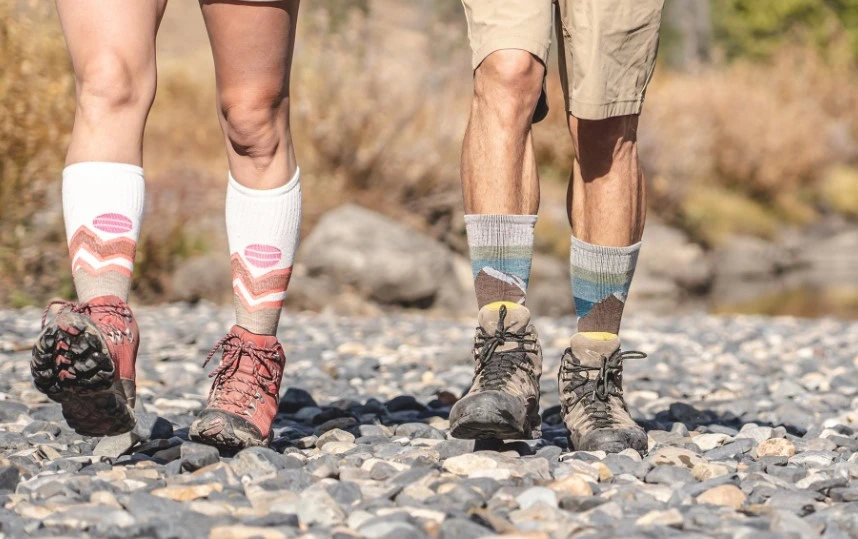
Compression socks are no longer just a medical necessity for improving circulation. They have become a versatile accessory that can enhance both comfort and style. Whether you’re dressing for work, heading to the gym, or attending a special event, knowing how to style compression socks can add an extra layer of functionality to your wardrobe. Stop hiding them! In this article, we’ll explore how to seamlessly integrate compression socks into different outfits, from casual to formal wear, making them a fashionable staple.
Overcoming the “Medical Look” — Why Fashionable Styling Matters

When it comes to compression socks, many people view them as purely functional, designed only for medical use or athletic recovery. However, as fashion trends evolve, compression socks have found their place in everyday outfits.
The Core Pain Point: User queries frequently revolve around words like “cute,” “fashion,” and “not attractive.” This signals that the user’s core problem is emotional—how to transform a functional, slightly medical-feeling garment into a desirable fashion accessory.
Your Fashion Advantage:
- Health and Comfort Hand-in-Hand: Compression socks are an excellent solution for improving circulation, preventing fatigue, and reducing swelling.
- Aesthetic Freedom: Modern compression socks come in diverse styles, vibrant colors, and rich patterns, allowing you to easily find a look that meets both your functional needs and your fashion taste.
Compression socks outfits: quick picks for work, casual, running, travel
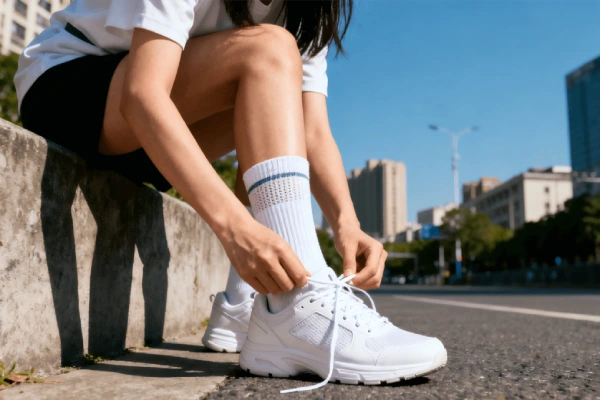
Work (office and client meetings)
- A sharp compression socks outfit: knee-high black or navy under dress pants, leather loafers, Oxford or Derby shoes, crisp shirt, minimal belt.
- Business casual: ribbed crew compression socks, chinos, loafers, knit polo or Oxford shirt.
- Formal days: thin, graduated pairs matched to trousers, low-profile dress shoes, blazer.
Casual (weekend and errands)
Casual wear offers the most flexibility when styling compression socks. Whether with jeans, shorts, or a casual dress, compression socks can seamlessly fit your everyday look. The key is: Don’t be afraid to show color and pattern!
- Street casual: mid crew compression socks, sneakers, cargos or relaxed jeans, tee or hoodie.
- Minimal casual: monochrome shorts set, ribbed crews, low tops.
- Sport casual: running shorts, breathable tee, trainers.
Running and training
- Race kit: knee-high performance compression socks, lightweight trainers, split shorts, singlet.
- Easy days: crew height, breathable mesh panels, tempo trainers, 2-in-1 shorts.
- Trail: merino blend crews, grip trail shoes, technical shorts.
Travel and long-standing
- Trade show days: cushioned crews, supportive sneakers, polo, and chinos.
- Airport outfit: thin knee-highs, joggers, breathable tee, slip-on sneakers.
- Work travel: chinos, thin compression socks, loafers you can remove fast, lightweight blazer.
Shoes to wear with compression socks
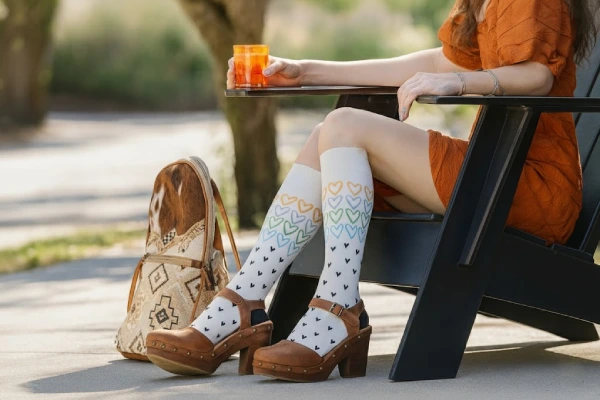
Looking for what shoes to wear with compression socks? Start with sneakers for casual days, loafers for office outfits, and low-profile dress shoes for formal looks. Each pair keeps the compression sock clean at the ankle and avoids bulk at the toe for a polished appearance.
Sneakers
- Best all-round choice for everyday outfits with compression socks.
- Choose low-profile uppers to reduce bunching at the ankle.
- Pair ribbed crews or knee-highs with shorts, joggers, or relaxed chinos.
- White, black, or tonal sneakers keep the look minimal.
Loafers
- Office-ready answer to what shoes to wear with compression socks.
- Pick penny or horsebit styles with a slim last for clean lines.
- Wear thin knee-highs with dress pants or ribbed crews with chinos.
- Match sock color to trousers for a seamless break.
Dress shoes
- Oxfords, Derbies, or plain-toe bluchers for formal outfits.
- Use thin, graduated compression socks to avoid tight toe boxes.
- Stick to black, dark brown, or oxblood for dress codes.
- Polish and shoe trees keep the silhouette sharp.
Boots
- Chelsea or chukka boots work with fall layers.
- Select lightweight uppers to prevent heat and bulk.
- Crew height socks avoid visible tops with mid-height shafts.
- For outdoor shifts, choose supportive work boots with breathable crews.
Heels
- For womenswear, pair knee-highs with midi dresses and block heels.
- Use thin denier look and neutral shades for formal settings.
- Check fit at the toes to prevent pressure.
- A slingback or low heel softens the line.
Outfits with compression socks: dresses, shorts, joggers
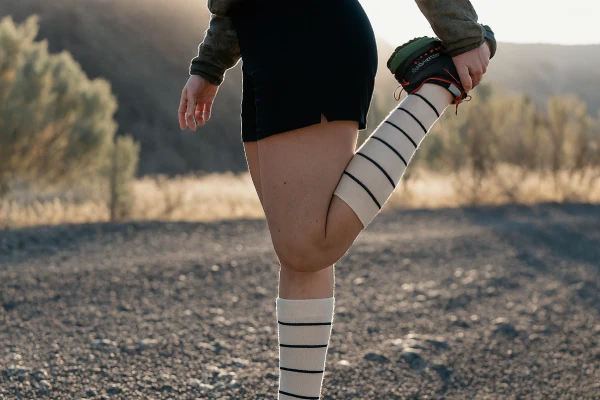
For outfits with compression socks, pair knee-high styles with midi dresses, ribbed crews with shorts in summer, and thin, graduated pairs with joggers for travel days.
Compression socks with dresses
- Midi and A-line dresses balance knee-high compression socks.
- For formal events, choose thin black or skin-tone pairs under hemlines.
- Casual day dresses work with patterned knee-highs and loafers or sneakers.
- Keep one hero element only: if socks are bright, keep the dress neutral.
How to wear compression socks with shorts
- Use crew or knee-high styles with 5–7 inch shorts.
- Color-match socks to shoes or top to keep the look intentional.
- Trainers or loafers both work. Avoid bulky high-tops that crowd the ankle.
- For running, pick breathable crews with moisture control.
Compression socks with joggers
- Airport-proof uniform: thin knee-highs, tapered joggers, slip-on sneakers.
- Tone-on-tone outfits read clean, like grey joggers with grey socks.
- Add a cap or light overshirt to finish the set.
- For standing jobs, select cushioned crews with arch support.
Cute compression socks for women: patterns and colors
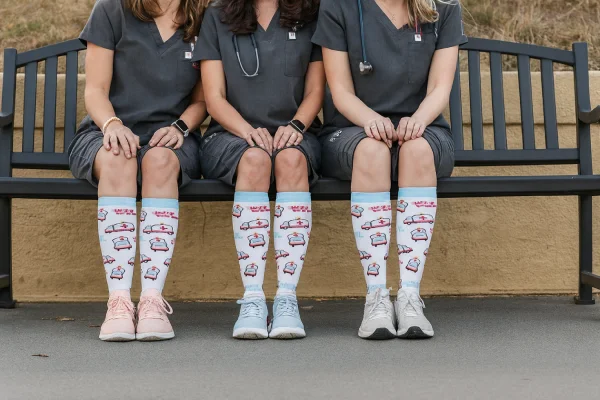
Cute compression socks for women look best when the pattern and color stay balanced. Stripes, micro-dots, and small florals add a playful but refined touch without overwhelming the outfit. Use one bright accent color at a time and repeat it in your shoes, bag, or knitwear to create a cohesive look. Monochrome sets—like all-black, all-navy, or soft beige—feel modern and minimal, making them easy to pair with both workwear and casual pieces. When wearing dresses, choose semi-opaque compression knits that resemble sheer hosiery but without shine; they flatter the leg, maintain a clean silhouette, and ensure comfort throughout the day.
How to make compression socks look good: fit, length, colors

- Fit: the fabric should lie flat with no wrinkles. If there is pinching, size up or switch to a thinner knit.
- Length: crews end mid-calf, knee-highs sit two fingers below the knee. Do not roll tops.
- Colors: match to trousers for a longer leg line or contrast for a statement.
- Fabric: thin knits for dress shoes, cushioned for sneakers, and long shifts.
Quick how-to: how to wear a compression sock properly
- Make sure skin is dry.
- Turn the sock inside out to the heel.
- Slide toes in, center the heel, then unroll up the leg in small sections.
- Smooth wrinkles. Do not fold or cuff.
- For medical use cases, follow clinician guidance on compression level and wear time.
FAQ Section
How do you style compression socks casually for women?
Start by selecting ribbed or colourful compression socks designed for fashion-friendly wear. Pair them with shorts, a T-shirt, or joggers and low-profile sneakers to maintain the flow of the outfit. Avoid shoes with high collars or bulky ankles, which can cause unwanted bunching at the top of the sock. Use one bright accent colour in the outfit and echo it in your accessories (bag, shoes, knit) so the socks feel intentional and styled, not just functional.
Can you wear compression socks with a dress or skirt, and how should you do it?
Yes. For women, choose knee-high or crew-length compression socks with semi-opaque knits that resemble sheer hosiery but retain the performance benefits. With a midi or A-line dress, pick a thin black or nude pair for a clean formal look. For casual skirts, a patterned or coloured pair adds personality if the rest of the outfit is toned down. Make sure the sock top is hidden or matches the skirt’s hemline so the look stays polished.
How to wear compression socks with shorts without the outfit looking awkward?
When styling compression socks with shorts, opt for crew or knee-high lengths so the sock height aligns with the shorts’ hemline and does not look mismatched. Match or complement the sock’s colour with your shoes or top to make it part of the overall palette rather than a random element. Stick with simpler prints if the rest of your outfit has bold patterns, and avoid thick shoes or bulky boots, which create an uneven silhouette at the ankle.
Is it okay to wear regular socks over compression socks?
Yes—this can be done in specific scenarios (e.g., outdoors, work boots), but it must be handled carefully. The outer sock must be thin and elastic to avoid adding pressure or causing wrinkles in the compression sock underneath, which can impair performance and comfort. Ensure the combination still allows the compression sock to lie flat and maintain smooth contact with the leg.
What are the best tips (or hacks) for putting on compression socks correctly to enhance style and comfort?
First, put on your compression socks in the morning when your legs are less swollen. Turn the sock inside-out to the heel, insert your foot, align the heel, then unroll gradually up the leg, smoothing wrinkles as you go. Avoid folding the top edge or cuffing the sock, which disrupts the fit and look. Use a donning aid if required (especially for higher compression levels). After wearing, rotate between pairs and wash gently to maintain elasticity and a crisp look.
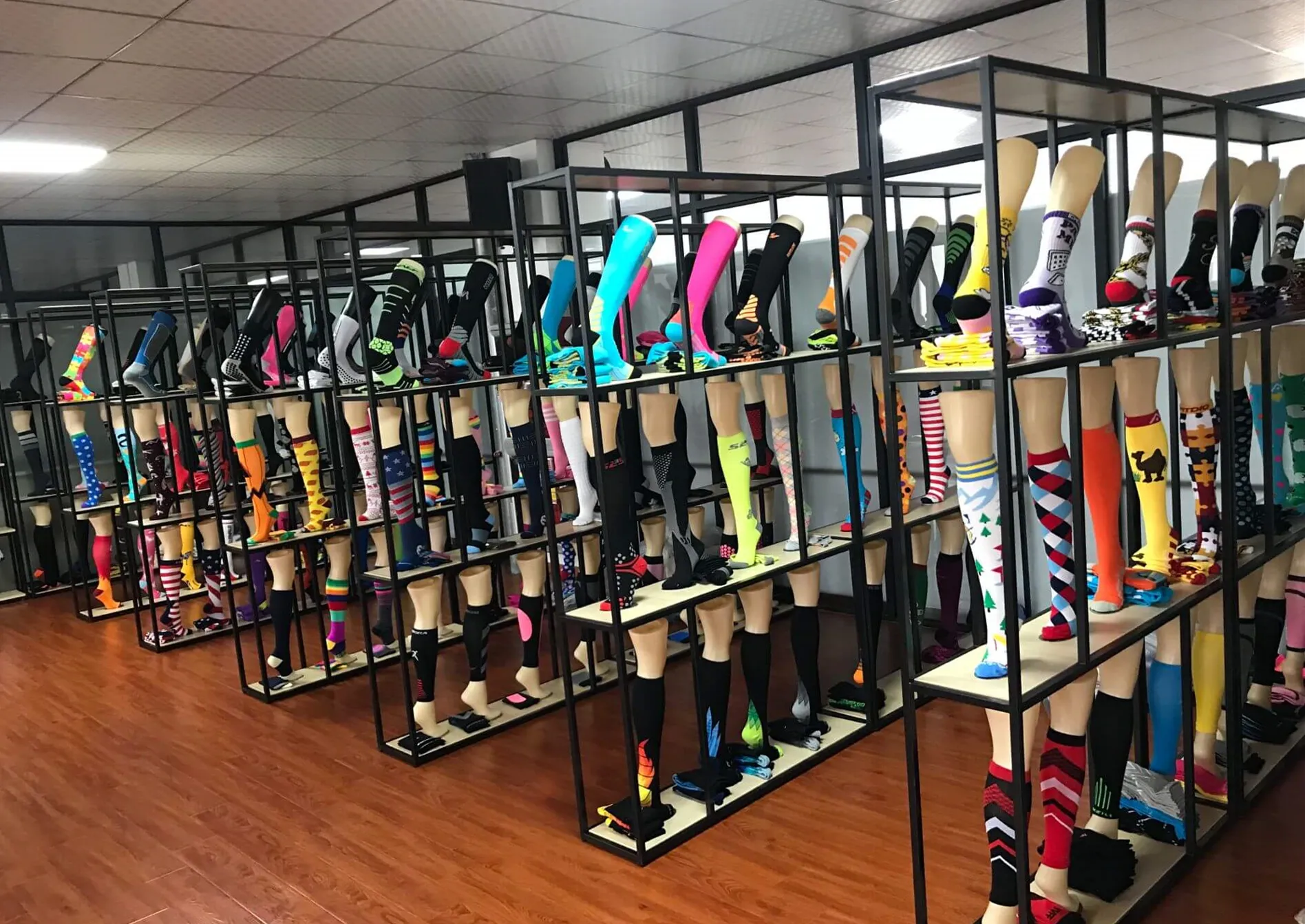
Do you need private-label or custom compression socks for teams, healthcare, retail, or giveaways? We manufacture to spec with custom lengths, yarn blends, and packaging. Contact our professional team or explore our custom compression socks.
